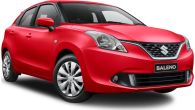More and more people are turning away from traditional sedans and hatchbacks in favour of high-riding SUVs.
While off-road flavoured SUVs offer better interior and boot space, many conventional cars tend to be relatively bland, but is there a practical and interesting alternative?
The Honda Jazz could be the answer, and with the VTi-S for the weekend, I set out to find out if this hatch is the ideal SUV substitute.
Saturday
The weather in Sydney was far from ideal on the first day of my weekend Jazz relationship, so I decided to get out of the city and head south in search of sunshine.
This would give me the chance to get better acquainted with the little Honda, which on paper looked to favour function over fun.
To me, the Jazz is like the Toyota Yaris or Hyundai Accent. It does what's needed but nothing more.
But that’s the point of small hatches, isn't it? Sure, but Suzuki, Volkswagen and Mazda have all managed to sprinkle some magic on their respected hatchbacks, resulting in cars that are fun to drive.
Yet, a trip to the Mt Keira lookout and surrounding Wollongong area (roughly 80km south of Sydney) might prove the Honda Jazz is more than your standard hatch.
Visually, the Jazz’s box shape, first seen in 2002 and tweaked a number of times over the years, remains fundamentally intact.
.jpg)
To my eyes, Honda has made the car uglier with each new generation. The early 2000s Jazz with factory bodykit and alloy wheels is much simpler and better looking than the 2018 version.
Side profile appears to be its best angle, but even in VTi-S trim, with 16-inch alloy wheels, sideskirts and a rear spoiler, the current generation is a bit of a mess.
Inside, the design isn’t too flash, either, especially the 7.0-inch touchscreen that quickly became my most disliked feature.
The multimedia system feels like an aftermarket unit. Navigating through the screens, it's slow to recognise inputs, while the sat nav is about as useful as sunscreen on a rainy day. Plus, there's no Apple CarPlay or Android Auto, so you have to rely on old fashioned Bluetooth to connect your phone.
.jpg)
On the drive out to Mt Keira, the cabin was full of noise from the engine and transmission.
The 1.5-litre four cylinder engine produces 88kW/145Nm which won't set your pants alight and is pretty standard for this class of car.
To get the most out of the the unit, it needs to be revved enthusiastically, which in return generates more noise.
.jpg)
Drive is fed to the front wheels via a Continuously Variable Transmission (CVT) and this type of auto is renowned for whining regardless of the car it's found in. This combination created enough racket during my travels that even a deaf person could hear it. Sadly, a manual gearbox is not an option on the VTi-S.
Once at Mt Keira the weather wasn’t any better, in fact the wind made it feel even colder, but at least the view was nice.
Much like the weather in Wollongong, the Jazz wasn't exactly impressing me, but maybe tomorrow would be a different story.
Sunday
It was another dreary day in Sydney, so it was out of the city again, this time up north to escape the rain.
The destination was Terrigal (89km from Sydney), and hopefully there would be some sun there.
Before setting off I investigated the boot space which is where the Jazz shines brightest. Honda’s ‘Magic Seats’, can be folded completely flat, and folded up, offering space that’s unrivaled in the class.
With the rear seats up, there is 354 litres (VDA) of boot space on offer, and with seats down that increases to 1314 litres.
These figures rival some small SUVs, and you can see why Honda chose this platform to underpin its HR-V.
The impressive boot doesn’t come at the expense of interior space either, with plenty of headroom and legroom in the cabin. In fact, inside it feels more like a shrunken people mover than an SUV.
It proved comfortable on both trips, with room to stretch out front and back, while the seats can accommodate people of all body types in comfort.
This is the VTi-S model which sits in the middle of the three-tier Jazz range, at $19,990 (before on road costs), and for $5000 over the entry-level VTi, you get alloy wheels, LED headlights, fog lights, a leather steering wheel, sat nav and a few other 'goodies'.
.jpg)
For the extra money you would expect the VTi-S to come with an array of safety equipment, however beyond the standard traction and braking aids, a reversing camera is the most advanced safety feature present.
There is no Auto Emergency Braking (AEB) of any sort or lane departure warning, even reverse parking sensors are an optional extra.
Stepping up to the VTi-L model will add these sensors but AEB is still absent, disappointing when it's standard on the base model Volkswagen Polo. At least there are six airbags in the Jazz, which is on par with the competition.
Honda claims an average fuel figure of 5.9L/100km, and by the end of the weekend I had recorded 6.7L/100km, but this number could have been lower if I'd managed to avoid a couple of frustrating traffic jams.
I finally rolled into Terrigal, managing to escape the rain and take in a bit of sun (albeit for about 10 minutes), and over the course of the second day my impression of the Jazz had brightened, as well.
Honda Jazz 2018: VTi-S
| Engine Type | Inline 4, 1.5L |
|---|---|
| Fuel Type | Unleaded Petrol |
| Fuel Efficiency | 5.8L/100km (combined) |
| Seating | 5 |
| Price From | $10,780 - $14,740 |
| Safety Rating |
|
Verdict
The Honda Jazz isn’t the most exciting small hatchback that money can buy and it's also lacking a lot of equipment that is fast becoming standard on other cars.
However, if you don’t want to go down the SUV path but you do want something that is practical and spacious for its size, look no further.
Would you take a Honda Jazz over a small SUV? Let us know in the comments.
Pricing Guides

.jpg)

.jpg)
.jpg)
.jpg)
.jpg)
.jpg)
.jpg)
.jpg)
.jpg)
.jpg)





































.jpg)
.jpg)



